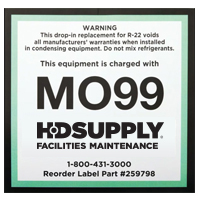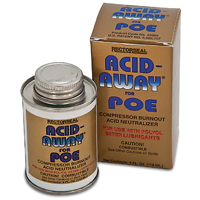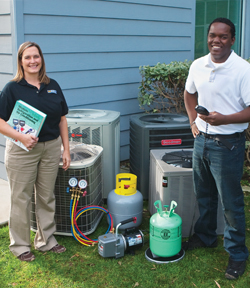Retrofit with R-22 Alternative Refrigerants
Because R-22 refrigerant is being phased out, HD Supply Facilities Maintenance and the Environmental Protection Agency (EPA) encourage you to develop a plan to transition away from Freon® R-22. Dozens of alternative refrigerants are available, and knowing which product is right for your situation is important.
The Chemours™ Company, the engineers of Freon R-22 gas and manufacturer of Freon® MO99™, has provided the following reference information. This material is intended to help ensure that the 400-Series alternative blend you choose offers the closest match to R-22 performance, minimizes component changes, and is most compatible with existing lubricants.

Important Considerations
Performance Match
Which alternative refrigerant performs closest to R-22?
What is this? There are many factors that go into the "ideal" R-22 replacement. Two of the most important to consider are capacity (the ability of an HVAC system to heat or cool the space) and energy efficiency (a coefficient of performance or COP).
Why is this important? Most of the no-oil change R-22 replacements have been measured to have slightly lower cooling capacities when compared to R-22; however, Freon MO99 provides a close capacity match to R-22. This means properly sized HVAC units will still be able to cool a space when converted over to Freon MO99.
What does this mean to me? Capacity differences between refrigerants following a retrofit can be seen in the run-time of a compressor. The greater the capacity loss, the longer the compressor needs to run to achieve the desired temperature. Freon MO99 is the closest capacity match to R-22, compared with most other no-oil change refrigerants.
What does this mean to my residents? The compressor will need to run a little bit longer to get to the desired room temperature. Since Freon MO99 is the closest capacity match to R-22, compared with most of the other no-oil change refrigerants, it will reach the desired set point before other, lower-capacity refrigerants. With Freon MO99, residents are unlikely to know a different refrigerant is even being used.

Component Changes
Do I need to make upgrades to my R-22 system in order to retrofit it with an alternative refrigerant?
What is this? The R-22 system is designed for specific pressures, mass flow rates, capacity, COP, and other factors. Mass Flow Rate is the primary indicator of whether your HVAC system will need a new expansion device in order to be properly retrofitted and run most efficiently. Suction pressure and discharge pressure should be considered for each appropriate operating condition.
Why is this important? Refrigerants with mass flow rates within 10 to 15% of R-22, with similar suction and discharge pressures, should not require any expansion device or line set changes during retrofit. Freon MO99 has a mass flow rate within 10% of R-22 and should not require expansion device changes.
What does this mean to me? Capacity differences between refrigerants following a retrofit can be seen in the run-time of a compressor. The greater the capacity loss, the longer the compressor needs to run to achieve the desired temperature. Freon MO99 is the closest capacity match to R-22 compared with most other no-oil change refrigerants.
What does this mean to my residents? Choosing an energy-efficient blend with a mass flow rate within 10 to 15% of R-22 helps reduce energy costs and shorten the system's downtime. It also reduces the likelihood of residents running into performance issues with their HVAC equipment over time.

Lubricant Compatibility Considerations
Do I need to change the compressor oil before I retrofit my HVAC systems with an alternative refrigerant?
What is this? Mechanical parts moving inside the compressor require proper lubrication to operate correctly. Throughout the history of the HVAC industry, different oils have been used to lubricate the compressor, depending on the standard refrigerant at the time. The standard oil for R-22 units is mineral oil, while HFC (hydrofluorocarbon) refrigerants like R-410A use a synthetic lubricant called polyolester oil (POE). It is an industry practice to add a small amount of hydrocarbons to an HFC blend to make it miscible with mineral oil (as is the case with Freon MO99). For A1-listed refrigerants such as Freon MO99, the hydrocarbons are at low enough levels for the blend to stay nonflammable and they can be handled just like R-22.
Why is this important? Incompatible refrigerant and oil pairings can cause oil logging in pipes and poor heat transfer in the evaporator, causing total compressor failure due to insufficient lubrication.
What does this mean to me? Total system failures result in substantial downtimes and money losses. To avoid lubricant compatibility issues, choose a refrigerant blend with a small amount of hydrocarbon for improved oil return in the system.
What does this mean to my residents? Using a no-oil change replacement will help minimize the amount of time the unit is down while also ensuring the compressor continues to run when residents need it the most.
400-Series Blend Considerations
What do I need to know about the 400-Series blends so I can confidently choose an alternative refrigerant?
What is this? Refrigerants are blended to optimize the properties of an original pure component refrigerant that is being regulated out of the marketplace. Each 400-Series blend has a differing number of components, but the number of components within each blend is irrelevant. For example, whether a blend has two components or six, typical system charging, servicing, and refrigerant handling practices are the same.
Why is this important? No 400-Series blend is a direct replacement for R-22. Mixing R-22 with a 400-Series blend, or mixing multiple 400-Series blends together, creates a new, untested refrigerant with unproven results. Use of alternative refrigerants voids all manufacturer warranties.
What does this mean to me? When retrofitting an HVAC system, drain all existing refrigerant from the system before adding a new refrigerant. Never mix refrigerants, or "top off" a system running on R-22 with a 400-Series blend. Once the R-22 is removed and the new refrigerant is charged into the unit, the system can be topped off with the new refrigerant. Never liquid charge into the low side, though.
Freon MO99 (R-438A) is the Preferred Alternative for Retrofitting
Freon MO99 is the gold standard for R-22 alternatives and was developed by the same scientists who engineered Freon R-22. The benefits of Freon MO99 include:
- Capacity — The ability of Freon MO99 to heat or cool a given space is closer to Freon R-22 than any other refrigerant on the market.
- Energy Efficiency (COP) — The ratio of compressor work required by Freon MO99 to heat or cool a given space is within 2% of R-22's.
- Mass Flow Rate & Pressure — Freon MO99's mass flow rate, suction pressure, and discharge pressure are similar to R-22's. Freon MO99 does not require component changes to fixed metering devices.
- Lubricant Compatibility — Freon MO99 is compatible with both mineral oil (the same oil used in R-22 systems) as well as synthetic lubricants such as alkyl benzene and polyolester oil (POE).
- Safety Rating — Freon MO99 is UL™ certified and has an ASHRAE A1 refrigerant safety classification. Freon MO99 is nonflammable.
Comparing Alternative Refrigerants to Freon R-22
Performance Match
Shown as a percentage as compared with R-22's performance.
| Freon MO99 (R-438A) | R-421A (Choice™) | R-422B (NU-22B®) | R-422D (Genetron®) | R424A (RS-44) | |
|---|---|---|---|---|---|
| Capacity (%) | -7% | -12% | -12% | -8% | -15% |
| (COP) Energy Efficiency (%) | -2% | -5% | -3% | -4% | -1% |
Component Changes
| Freon MO99 (R-438A) | R-421A (Choice™) | R-422B (NU-22B®) | R-422D (Genetron®) | R424A (RS-44) | |
|---|---|---|---|---|---|
| Component Change Requirements | Not Required | Suggested for fixed metering devices | Suggested for fixed metering devices | Suggested for fixed metering devices | Not Required |
| Mass Flow* | 12% | 21% | 20% | 32% | 12% |
| Suction Pressure (psi) | -3 | -7 | -6 | 1 | -11 |
| Discharge Pressure (psi) | 5 | -7 | -5 | 12 | -17 |
*Shown as a percentage as compared to R-22's performance
Compatibility with Lubricant
Warning: R-421A has oil in the cylinder, which could be flammable.
| Freon MO99 (R-438A) | R-421A (Choice™) | R-422B (NU-22B®) | R-422D (Genetron®) | R424A (RS-44) | |
|---|---|---|---|---|---|
| Hydrocarbon Element Present* | Yes | No | Yes | Yes | Yes |
| Discharge Temperature (°F) | -30 | -36 | -37 | -39 | -38 |
| Temperature Glide | 7 | 7 | 6 | 5 | 5.5 |
*When hydrocarbon element is present, there is greater refrigerant and oil compatibility.
Retrofit to Freon MO99 in 8 Easy Steps
Complete guidelines with images to help you retrofit your R-22 system to Freon MO99 are available.
- Review Freon M099 retrofit guidelines
- Check baseline performance of R-22
- Recover R-22 from system
- Replace filter drier
- Replace schrader valve cores
- Pull a vacuum on your system to check for leaks and, if found, repair
- Charge system with Freon MO99 to the proper superheat or sub-cool (charge as a liquid)
- Label the system with a Freon MO99 sticker
- Disconnect hoses, clean hoses with nitrogen, and place recovery cylinder in a cool place out of direct sunlight.
- When the recovery tank is at 80% capacity, call us to order the Reclamation Service 50lbs cylinder for exchange.
Know the Facts About Alternative Refrigerants
Complete guidelines with images to help you retrofit your R-22 system to Freon MO99 are available.
- They should not be combined with R-22 refrigerant or other gases; never mix refrigerants
- They are best suited for equipment out of warranty, since the use of alternative refrigerants voids all manufacturer warranties
- They are non-ozone-depleting hydrofluorocarbons (HFCs)
- When given an ASHRAE number (designated with an R-), they have been reviewed by the industry standards committees and a safety classification has been assigned
For more information on the Freon® family of refrigerants, or other refrigerant products, visit Chemours.
The information set forth herein is provided exclusively by Chemours and is based on technical data that Chemours believes to be reliable. It is intended for use by persons having technical skill, at their own risk. Because conditions of use vary, Chemours and HD Supply Facilities Maintenance make no warranties, expressed or implied, and assume no liability in connection with any use of this information.
©2019 The Chemours Company FC, LLC. Freon and any associated logos are trademarks or copyrights of The Chemours Company FC, LLC. Chemours and the Chemours Logo are trademarks of The Chemours Company.

Definitions of Terms
A1 Listing — Refrigerants are classified by toxicity (either class A or class B) and flammability (either class 1, class 2, or class 3.) Class A is used to designate refrigerants with toxicity less than or equal to 400 ppm. Class 1 refrigerants do not show flame propagation in the air at 21°C and 101 kPa. The A1 Listing is the best safety rating available for refrigerants.
Capacity — The ability of an HVAC system to heat or cool a given space.
Coefficient of Performance (COP) — The ratio of heating or cooling to work required to heat or cool. The higher the COP, the lower the operating costs.
Discharge Pressure — Output pressure generated by the system compressor while operating. This is also known as high side pressure or head pressure.
Low Side Pressure — Intake pressure generated by the system compressor while operating. This is also known as suction pressure.
Head Pressure — Output pressure generated by the system compressor while operating. This is also known as discharge pressure or high side pressure.
High Side Pressure — Output pressure generated by the system compressor while operating. This is also known as discharge pressure or head pressure.
Seasonal Energy Efficiency Ratio (SEER) — An energy efficiency rating for central air conditioners that is calculated by dividing Btus per hour for each watt of power drawn by the system.
Suction Pressure — Intake pressure generated by the system compressor while operating. This is also known as low side pressure.
Temperature Glide — The measurement in Fahrenheit where a refrigerant will boil or condense at a constant temperature.
